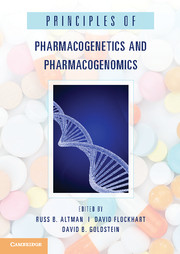Book contents
- Frontmatter
- Contents
- Contributors
- Introduction
- I Critical Concepts
- 1 Introduction to Population Diversity and Genetic Testing
- 2 Genotyping Technologies
- 3 Pharmacokinetics: Absorption, Distribution, Metabolism, Excretion Overview Chapter
- 4 Overview: Adverse Drug Reactions
- 5 PharmGKB, a Centralized Resource for Pharmacogenomic Knowledge and Discovery
- 6 DrugBank
- 7 Ethical Considerations for Pharmacogenomics: Privacy and Confidentiality
- 8 Informed Consent in Pharmacogenomic Research and Treatment
- 9 Legal Trends Driving the Clinical Translation of Pharmacogenomics
- II Therapeutic Areas
- References
2 - Genotyping Technologies
from I - Critical Concepts
Published online by Cambridge University Press: 05 June 2012
- Frontmatter
- Contents
- Contributors
- Introduction
- I Critical Concepts
- 1 Introduction to Population Diversity and Genetic Testing
- 2 Genotyping Technologies
- 3 Pharmacokinetics: Absorption, Distribution, Metabolism, Excretion Overview Chapter
- 4 Overview: Adverse Drug Reactions
- 5 PharmGKB, a Centralized Resource for Pharmacogenomic Knowledge and Discovery
- 6 DrugBank
- 7 Ethical Considerations for Pharmacogenomics: Privacy and Confidentiality
- 8 Informed Consent in Pharmacogenomic Research and Treatment
- 9 Legal Trends Driving the Clinical Translation of Pharmacogenomics
- II Therapeutic Areas
- References
Summary
With the release of the Human Genome Mapping Project data (1) and the subsequent International HapMap Project (2), a wealth of genotype information is now publically available to researchers. Pharmacogenomics can utilize this information to its advantage by screening patient samples for known functional or tagging polymorphisms and deriving associations with drug outcome and toxicity. In addition, where no known functional polymorphisms have been identified in genes involved in drug pathways, technologies have emerged to perform whole-genome screens to find novel genome regions for further study.
Often considered the “gold standard” of genotyping, Sanger sequencing performed on the same DNA region in multiple individuals (resequencing) can be used to identify both new and previously reported polymorphisms. However, this process is not cost-effective, and analysis time can be slow. Consequently, it is often used as a quality-control step to confirm genotypes reported through the various technologies discussed later in this chapter.
- Type
- Chapter
- Information
- Principles of Pharmacogenetics and Pharmacogenomics , pp. 12 - 20Publisher: Cambridge University PressPrint publication year: 2012

